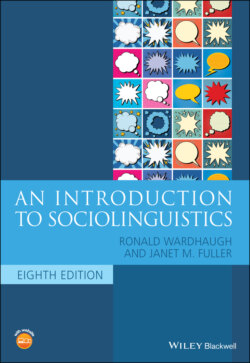Читать книгу An Introduction to Sociolinguistics - Ronald Wardhaugh, Janet M. Fuller - Страница 38
Language or Dialect?
ОглавлениеFor many people there is no confusion at all about what language they speak. For example, they are Chinese, Japanese, or Korean and they speak Chinese, Japanese, and Korean, respectively. In these cases, many people see language and ethnicity or nationality as virtually synonymous (Coulmas 1999). However, for many people, there is no one‐to‐one correlation between these categories; some people are both Chinese and French, or may identify as simply Canadian, not Korean Canadian, regardless of what languages they speak.
Most people can give a name to their language(s). On occasion, some of these names may appear to be strange to those who take a scientific interest in languages, but we should remember that human naming practices often have a large ‘unscientific’ component to them. Census‐takers in India find themselves confronted with a wide array of language names when they ask people what language or languages they speak. Names are not only ascribed by region, which is what we might expect, but sometimes also by caste, religion, village, and so on (see Mallikarjun 2002). Moreover, they can change from census to census as the political and social climate of the country changes.
Linguists use the term vernacular to refer to the language a person grows up with and uses in everyday life in ordinary, commonplace, social interactions. We should note that so‐called vernaculars may meet with social disapproval from others who favor another variety, especially if they favor a variety heavily influenced by the written form of the language. Therefore, this term often has pejorative associations when used in public discourse. The vernacular is often contrasted with a standardized language, which we will discuss in depth below.
Haugen (1966) has pointed out that language and dialect are ambiguous terms. Although ordinary people use these terms quite freely in speech, for them a dialect is almost certainly no more than a local non‐prestigious (therefore powerless) variety of a ‘real’ language. In contrast, scholars may experience considerable difficulty in deciding whether one term should be used rather than the other in certain situations. How, then, do sociolinguists define the difference between a dialect and a language?
First, we need to look at the history of these terms. As Haugen says, the terms ‘represent a simple dichotomy in a situation that is almost infinitely complex.’ The word ‘language’ is used to refer either to a single linguistic norm or to a group of related norms, and ‘dialect’ is used to refer to one of the norms.
A related set of terms which brings in additional criteria for distinction is the relationship between what the French call un dialecte and un patois. The former is a regional variety of a language that has an associated literary tradition, whereas the latter is a regional variety that lacks such a literary tradition. Therefore, patois tends to be used pejoratively; it is regarded as something less than a dialect because it lacks an associated literature. Even a language like Breton, a Celtic language still spoken in parts of Brittany, is called a patois because it lacks a strong literary tradition and it is not some country’s language. However, dialecte in French, like Dialekt in German, cannot be used in connection with the standardized language, that is, no speaker of French considers Standard French to be a dialect of French, and in German to tell someone they speak a Dialekt means that they do not speak Standard German (called Hochdeutsch ‘High German’). In contrast, it is not uncommon to find references to Standard English as being a dialect – admittedly a very important one – of English.
Haugen points out that, while speakers of English have never seriously adopted patois as a term to be used in the description of language, they have tried to employ both ‘language’ and ‘dialect’ in a number of conflicting senses. ‘Dialect’ is used both for local varieties of English, for example, Yorkshire dialect, for various types of informal speech, or for lects associated with uneducated or rural speakers. The term ‘dialect’ often implies nonstandard or even substandard, and can connote various degrees of inferiority, with that connotation of inferiority carried over to those who speak a dialect. This is part of what we call the standard language ideology, and we will have more to say about it below.
In the everyday use of the term, ‘language’ is usually used to mean both the superordinate category and the standardized variety; dialects are nonstandard and subordinate to languages. Sociolinguists view this issue somewhat differently; every variety is a dialect, including the standardized variety, and the reason we see some varieties as dialects of the same language is based on sociopolitical, not linguistic, criteria. Although linguistic criteria do play a role in the next topic we will discuss, mutual intelligibility of varieties, as we will see this is not the deciding factor in the language – dialect distinction.
